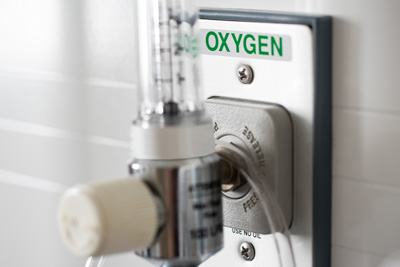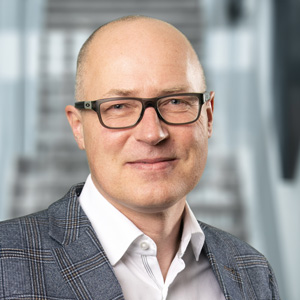How is a damp cellar related to unnecessary resource consumption?
Sometimes, innovations emerge from the most unusual situations. This story did not begin in a hospital, lecture hall or laboratory, but in a private home – more precisely, in a damp cellar. This became the starting point for an exciting journey of discovery in the hospital.
Background
Why is the cellar damp? This question marked the beginning of our journey. A craftsman explained the physical relationships between water, temperature and, where applicable, air pressure. The insight gained from this was that gases can be humidified. Inspired by this moment of revelation, we took this new knowledge with us into a technical discussion about the humidification of oxygen in hospitals – a common practice in our field. Oxygen is a dry gas and is therefore humidified with sterile water to prevent possible side-effects such as dry mucous membranes. However, a colleague reported that humidifying oxygen was no longer state-of-the-art. This led to a stalemate in our discussion, with different arguments on both sides: physical principles, established traditions and new recommendations. We needed a clear answer.

The search for answers
Nurses in Lower Austria have the opportunity to obtain evidence-based answers to clinical questions at the University for Continuing Education Krems. This service facility (www.ebninfo.at) is financially supported by the Lower Austrian Health and Social Fund and produces rapid reviews – i.e. accelerated syntheses of studies. As a contribution to our clinical decision-making, colleagues from a hospital requested this service. We wanted to obtain a critical appraisal and synthesis of the scientific evidence on the benefits of oxygen humidification (≤5 litres flow per minute) and whether humidification brings advantages for patients. The evidence-based answer showed that there is little to no difference between humidified and non-humidified oxygen – neither in terms of nosebleeds nor dryness in the nasopharynx. With this result, we continued the discussion – including in our hospital's internal journal club. In our regular journal clubs, we evaluate study results, such as those from rapid reviews, in terms of their applicability, specifically their feasibility, appropriateness, meaningfulness and effectiveness.(1-2) If the criteria are met, we summarise the results through one-minute information (OMI) posters. The aim is to positively influence planned implementations of new methods or de-implementations. In this case, it was not a new measure but a de-implementation, i.e. the removal of routines. De-implementation involves actively removing measures that have little or no benefit, or even do more harm than good, from everyday care. These measures are often based on outdated knowledge or traditions. The routine humidification of ≤ 5 litres of oxygen per minute (low flow) is one such measure, as it is more a tradition than a necessity. Our intended de-implementation of routine humidification of low-flow oxygen using evidence-based OMI had surprising effects.
‘One-minute information’ as a measure for de-implementation?
OMIs are summaries of evidence-based answers with a clear implication for practical action. We hang these posters in places where healthcare professionals pause (or have to pause), e.g. point-of-care devices such as blood gas analysers, coffee machines or even toilets. The aim is to pass on knowledge in a low-threshold, simple and quick manner (<1 minute). The idea of OMI has been spreading rapidly for years and is now commonly used in German-speaking countries.(3-6) However, it is unclear whether this is merely a ‘nice’ idea or whether it also has a measurable impact.
This is where it got particularly exciting. We asked ourselves whether de-implementation using OMI is effective. Out of pure curiosity, we analysed possible relevant parameters for successful de-implementation. Not only the obvious material costs were examined, but also other parameters, such as working time, logistics, disposal and even noise levels. To this end, order lists were requested, time and volume calculations were carried out and queries were made to colleagues.
The results
The effects go far beyond patient-related outcomes. Human resources were freed up, material costs fell, logistics were simplified, plastic waste disposal was reduced and a contribution to climate change mitigation was made. This is particularly important because the healthcare system is one of the major contributors to climate-damaging greenhouse gases, accounting for around 4.4% of global net emissions.(1) This example shows how practical research collaborations bring benefits far beyond benefits for patients. Specifically, the following results were achieved:
Material costs and budget: Product orders fell in the years following the presentation of the OMI from 11,383 units in 2021 to 6,595 units in 2024. This corresponds to a reduction of around 42%. Financially, this is not a revolutionary contribution to the budget (minus €7,800), but it is still a noticeable effect.
Human resources: This is where things got even more exciting. Nurses reported spending around 5 minutes per oxygen connection (installation or replacement of the humidifier). The time saved adds up to a considerable amount over a year: approximately 24,000 minutes or 400 working hours. This is valuable working time saved in an already strained staffing situation, which can be put to better use elsewhere. The time required for ordering and local storage has not even been taken into account here.
Storage and logistics: The calculations showed a material volume saving of around 7m³ per year. This not only reduces storage capacity in the hospital and wards but also reduces transport distances and the associated CO₂ emissions.
Disposal and environment: Less material also means less waste. This has reduced both disposal costs and CO₂ emissions from transport and thermal disposal of waste.
Noise: Another effect can be seen in relation to the already high noise levels in hospitals. The de-implementation of oxygen humidification reduces noise in patient rooms – an advantage for patients and their neighbours alike. Decibel measurements of the bubbling or hissing noise caused by humidification are still pending, but nursing staff and patients are already reporting positive effects. The bubbling of the humidifiers often led patients to think that it had been raining all night, which made it harder for them to sleep. This problem has now been virtually eliminated.
Curiosity pays off
Our efforts to put evidence-based knowledge into practice using OMI seem to be successful, at least in this case. However, we also encountered some challenges: our analyses were not planned from the beginning. Much of the data was only collected retrospectively. For future projects, we want to take a more systematic approach: setting clear goals, defining outcomes and collaborating more with researchers.
It all started with a damp cellar – a personal problem that ultimately sparked something much bigger. This experience initially led to a better understanding of the physical principles of air humidification. This led to technical contributions to discussions about oxygen humidification in hospitals. Although these ideas did not provide the answer to our question, they fuelled our discussions and the need for a substantiated answer. We obtained this through scientific evidence, which we were then able to reflect on and transfer into professional practice. In this way, a private event helped to promote a sustainable and positive development in a larger context respectively our hospital.
Next steps
The plan now is to conduct an initial life cycle analysis for humidification products (single-use products). Such analyses are based on the use of a product and should take all aspects into account, from material extraction to disposal and recycling.(7) The aim is to examine the environmental impact of a product throughout its entire ‘life cycle’. However, such analyses require considerable effort and collaboration with experienced experts. In addition, the impact of OMI and other strategies and methods for implementation and de-implementation should be further developed and analysed in collaboration with scientists and reviewed for effectiveness. This project followed curiosity in retrospect and showed surprising results – future projects should be carried out in advance, more systematically and theory-driven, as a partnership between clinicians and researchers.
Key take-home messages:
1. Questioning routines can trigger important developments. What was once considered correct may no longer be appropriate today.
2. De-implementation can also be done with a clear conscience and bring a variety of benefits. Less can also be more.
3. De-implementation is not only exciting and fascinating but also shows that a close connection between practice and research is essential and fruitful.
4. The elimination of unnecessary measures not only benefits patients, but also our environment – an aspect that is becoming particularly important in times of climate change. This project can also raise awareness of sustainable working practices in the healthcare sector – without harming patients.
5. Sustainability in healthcare is possible – and necessary.
Conclusion
Sometimes it is enough to reflect on experiences and talk openly about routines. Targeted de-implementation can reduce costs and workload – while protecting patients, staff and the environment. The interplay of curiosity, scientific methods and practical implementation creates genuine win-win situations.
References
1. Weisz U, Pichler P-P, Jaccard IS, Haas W, Matej S, Bachner F, et al. Carbon emission trends and sustainability options in Austrian healthcare. Resources, Conservation and Recycling. 2020;160:104862.
2. JBI. Adopting evidence into practice 2025. Available from: https://jbi.global/news/article/adopting-evidence-practice.
3. Schleswig-Holstein University Hospital. One Minute Wonder 2025. Available from: https://www.uksh.de/Pflege/Unsere+Pflegenden/Pflegewissenschaften/One+Minute+Wonder.html.
4. Haus der Barmherzigkeit Institute. One Minute Wonder – smart knowledge transfer. 2025. Available from: https://www.hb.at/ueber-uns/expertise/one-minute-wonder/.
5. FH Gesundheitsberufe OÖ GmbH. One-minute papers as a learning method in healthcare and nursing 2025. Available from: https://www.fh-gesundheitsberufe.at/neuigkeiten/one-minute-paper-als-lernmethode-in-der-gesundheits-und-krankenpflege/.
6. Krüger L, Mannebach T, Rahner M, Timpe F, Wefer F, Nydahl P. Learning in one minute: survey of the One Minute Wonder Network. Med Klin Intensivmed Notfmed. 2022;117(2):159-67.
7. McAlister S, Morton RL, Barratt A. Incorporating carbon into health care: Adding carbon emissions to health technology assessments. Lancet Planet Health. 2022;6(12):e993-e9.
To link to this article - DOI: https://doi.org/10.70253/KCJG6792
Hyperlinks:
State-of-the-art: https://register.awmf.org/assets/guidelines/020-021l_S3_Sauerstoff-in-der-Akuttherapie-beim-Erwachsenen_2021-06-verlaengert.pdf
answers to clinical questions: https://ebninfo.at/wp-content/uploads/IZP_Methoden_Manual_Update_2025.pdf
University for Continuing Education Krems: https://www.donau-uni.ac.at/en.html
www.ebninfo.at: www.ebninfo.at
Lower Austrian Health and Social Fund: https://www.noegus.at/
evidence-based answer: https://ebninfo.at/befeuchtung_der_sauerstoffinsufflation/
Disclaimer
The views expressed in this World EBHC Day Blog, as well as any errors or omissions, are the sole responsibility of the author and do not represent the views of the World EBHC Day Steering Committee, Official Partners or Sponsors; nor does it imply endorsement by the aforementioned parties.

Martin Fangmeyer is a nurse, nurse scientist and lecturer. He works at the University for Continuing Education Krems at the Department for Evidence-based Medicine and Evaluation, Cochrane Austria and is Head of the Evidence-based Information Centre for Nurses and Co-Director of JBI Austria.
Denise Lechner is an Advanced Practice Nurse in the Intensive Care Unit at St. Pölten University Hospital. She is the Head of the Journal Club, where she fosters evidence-based practice and research integration in clinical nursing.
Peter Redl-Lenk is a nursing expert, lecturer and creative mind in the department for organisational development, controlling and project management, as well as head of clinical ethics consulting at St. Pölten University Hospital.